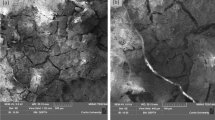Abstract
Archaeological silver may become brittle owing to long-term corrosion and microstructural changes. Recognition and determination of corrosion-induced and microstructurally induced embrittlement, and also their synergy, are important for artifact conservation and possible restoration. This article considers the types of embrittlement, diagnostic techniques, and remedial measures.
Similar content being viewed by others
References
F.C. Thompson and A.K. Chatterjee, “The Age-Embrittlement of Silver Coins,” Studies in Conservation, 1 (1954), pp. 115–126.
A.E. Werner, “Two Problems in the Conservation of Antiquities: Corroded Lead and Brittle Silver,” Application of Science in Examination of Works of Art, ed. W.J. Young (Boston, MA: Boston Museum of Fine Arts, 1965), pp. 96–104.
R.M. Organ, “The Current Status of the Treatment of Corroded Metal Artifacts,” Corrosion and Metal Artifacts, Special Publication 479 (Washington, D.C.: National Bureau of Standards, 1977), pp. 107–142.
M. Kallfass, J. Paul, and H. Jehn, “Investigations on the Embrittlement of an Antique Roman Silver Bowl,” Praktische Metallografie, 22 (1985), pp. 317–323.
I.G. Ravich, “Annealing of Brittle Archaeological Silver: Microstructural and Technological Study,” Preprints of the 10th Triennial Meeting of the International Council of Museums Committee for Conservation (Washington, D.C., 1993), pp. 792–795.
R.J.H. Wanhill et al., “Damage Assessment and Preservation of an Egyptian Silver Vase (300–200 BC,” Archaeometry, 40 (1998), pp. 123–137.
R.J.H. Wanhill, “Archaeological Silver Embrittlement: A Metallurgical Enquiry,” National Aerospace Laboratory NLR Technical Publication NLR-TP-2002-224 (Amsterdam: National Aerospace Laboratory NLR, 2002).
F. Schweizer and P. Meyers, “A New Approach to the Authenticity of Ancient Silver Objects: The Discontinuous Precipitation of Copper from a Silver-Copper Alloy,” Proceedings of the 18th Int’l. Symposium on Archaeometry and Archaeological Prospection (Cologne: Rheinland-Verlag GmbH., 1978), pp. 287–298.
W. Gowland, “Silver in Roman and Earlier Times: I. Pre-historic and Proto-historic Times,” Archaeologia, 69 (1918), pp. 121–160.
D.A. Scott, “Technical Study of a Ceremonial Sican Tumi Figurine,” Archaeometry, 38 (1996), pp. 305–311.
C.S. Smith, “The Interpretation of Microstructures of Metallic Artifacts,” Application of Science in Examination of Works of Art. ed. W.J. Young (Boston, MA: Boston Museum of Fine Arts, 1965), pp. 20–52.
L. Ercker, Treatise on Ores and Assaying, Translation of Second Edition of 1580 by A.G. Sisco and C.S. Smith (Chicago, IL: University of Chicago Press, 1951), pp. 80–81, 191–198.
A.L. Norbury, “The Effect of Quenching and Tempering on the Mechanical Properties of Standard Silver,” Journal of the Institute of Metals, 39 (1928), pp. 145–172.
M.P. Seah, “Adsorption-Induced Interface Decohesion,” Acta Metallurgica, 28 (1980), pp. 955–962.
W.A. Oddy and R. Holmes, “The Hockwold Treasure,” The Art of the Conservator, ed. W.A. Oddy (London: British Museum Press, 1992), pp. 137–150.
J. van Reekum and E. Moll, “Coating Silverware: From Daily Use to Museum Object,” Zeven IJzersterke Verhalen over Metalen (in Dutch), ed. H.A. Ankersmit and J.A. Mosk (Amsterdam: Netherlands Institute for Cultural Heritage, 2000), pp. 74–79.
R. Wood, “To Protect and Preserve,” Materials World, 8 (2000), pp. 30–32.
Author information
Authors and Affiliations
Additional information
Russell Wanhill is with the National Aerospace Laboratory NLR in the Netherlands.
Rights and permissions
About this article
Cite this article
Wanhill, R. Embrittlement in archaeological silver artifacts: Diagnostic and remedial techniques. JOM 55, 16–19 (2003). https://doi.org/10.1007/s11837-003-0168-x
Issue Date:
DOI: https://doi.org/10.1007/s11837-003-0168-x




